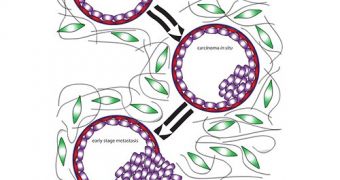In a study that sheds a new light on the earliest stages of breast cancer metastasis, researchers at the Rensselaer Polytechnic Institute (RPI) were able to discover a previously-unknown connection between breast cancer cells and healthy cells surrounding the tumor.
The research suggests that a molecule called cadherin-23 may play a significant role in the first stages of metastasis development. This also implies that it could potentially be used as a target for novel therapies aimed at this condition.
RPI biologist Lee Ligon, the leader of the study, conducted the work with PhD student Maria Apostolopoulou. Details of their work appear in a paper called “Cadherin-23 Mediates Heterotypic Cell-Cell Adhesion between Breast Cancer Epithelial Cells and Fibroblasts.”
The research is published in the March 7 issue of PLoS ONE, a journal of the Public Library of Science. Funds for the team were provided by the American Cancer Society. One of the main conclusions is that cadherin-23 permeates breast cancer cells.
Significant amounts of the molecule are also present in the stroma, the connections that bind the diseased cells to the healthy tissue surrounding it. Cadherin-23 was never before linked with breast cancer in any way.
“Something happens once cancerous cells enter the stroma and the cancer can very quickly become invasive. Pathologists studying cancerous tissues have often noted that tumor cells make contact with the cells in the stroma, but they assumed the connections were unimportant,” Ligon explains.
Cadherin-23 is part of a family of molecules called cadherins, whose primary role in the human body is to connect cells together. Usually, only cells of the same type are bound, but the new data suggests that cadherin-23 breaks the norm, connecting cancer cells to surrounding, healthy tissue.
“Cadherin-23 has never before been associated with cancer. In fact, it has previously only been shown in the sophisticated inner workings of the ear and retina,” Ligon says. At this point, her team still has a long road ahead before the findings can be put to practical use.
The exact mechanism through which this molecule acts is not yet known, but the team says that a link must be there if such high concentrations are found all around tumor sites.
As soon as the way it acts is fully understood, researchers will proceed towards finding a way of addressing breast cancer via this molecule.

 14 DAY TRIAL //
14 DAY TRIAL //